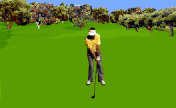This whole month I am guilty of practicing only on mats at the range. ?Usually that’s no biggie but sometimes it can make you think you are hitting the ball awfully well but you might actually “not” be.
I did hit up the grass tees couple times lately at the range and notice something funny, I was taking rather large divots. ?Although I hit the ball good, making big and thick divots can make you hit “fliers”, ball with too much overspin and goes farther than you expected.
It’s always good to take the less divot as possible, especially if you hit the ball long like me. ?For most long hitters, hitting a flier can become a big problem as your error (of hitting fliers/too much divot) literally multiplies.
Also, divots should be as shallow as possible. ?Plus, by taking shallow divots, you are putting less strain on your hands, which also allows you to achieve higher swing speeds.
Bryon Nelson used to take huge divots that looked literally like a dollar bill. ?Of course, his divots were also “thin” as dollar bill.
My point here is that you want to make the shallowest, smallest divot possible because when you do that, it means you are getting more of the clubface onto the ball.
For long irons and woods off the fairway, you probably don’t even need any divot because your swing arc becomes shallow.
For middle to short irons off the fairway, a nice shallow divot starting “after” the ball is struck, would be ideal.
Most likely if you are making big-a** divots, there can be several reasons.
First, your golf clubs might be not probably fitted. ?If your taller or shorter than average AND you use standard-size golf clubs, you are probably gonna dig that toe or heel end of the clubhead into the ground at impact, throwing off your shot and also cause bigger divots. ? This is number one mistake I see among amateurs, they buy $2000 golf clubs and forget to custom-fit it to their body by getting longer shafts or cutting them to fit. ?Also, there’s the loft and lie angles of the clubhead you NEED to adjust. ? These things can all be done correctly if you ask your golf shop before ordering them. ?Don’t get lazy.
If you don’t custom-fit your clubs, that’s like buying medium size T-shirts and giving it to your super tall/skinny daughter and super short/fat son who needs to wear 2XXL.
Second, if you are making big divots, examine what they look like. ? For example, today I noticed that my divots were actually “aligned” about 15 yards left of my target, meaning my clubhead was closed at impact. ? The real cause of this closed clubface was because I didn’t rotate my clubhead and body enough to the right on my backswing.
I fixed it by making sure to “turn and rotate” my clubhead and body starting from address. ? Voila, I started making very, very thin and shallow divots again, the ones I am used to when I shoot under par.
Also, one more tip, when you are playing in the wind, actually try hitting the ball a bit thin. ?What this does is keeps your ball flight down and puts less backspin on your ball, which makes your shot less vulnerable to the wind.
You can practice these slightly “thin” shots by really keeping your upper body “UP” throughout the swing. ?Plus, these can come in reaaaaal handy out of those fairway bunkers, allowing you to easily hit the green when you have a decent lie.
Well, I just told you what kind of divots you should be making out there (and some wind-play secrets), don’t forget to subscribe!
P.S. I am actually in the process of writing my new golf book, “How to Lower Your Golf Scores”, if you want a free review copy, let me know at the comments line!
If you want to improve your swing, try the Medicus Driver.For deals on golf clubs, don't forget to check out Golfsmith Outlet store and GlobalGolf for used golf clubs.





No comments:
Post a Comment